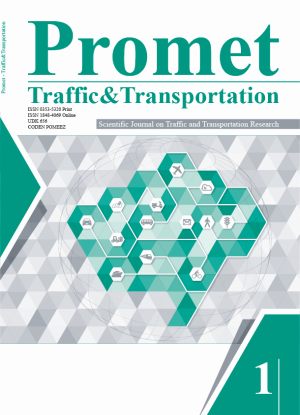Regional Expressway Freight Volume Prediction Algorithm Based on Meteorological Information
DOI:
https://doi.org/10.7307/ptt.v35i2.40Keywords:
road transportation, forecast of freight volume, machine learning, expressway, meteorological informationAbstract
In the post-epidemic era, dynamic monitoring of expressway road freight volume is an important task. To accurately predict the daily freight volume of urban expressway, meteorological and other information are considered. Four commonly used algorithms, a random forest (RF), extreme gradient boosting (XGBoost), long short-term memory (LSTM) and K-nearest neighbour (KNN), are employed to predict freight volume based on expressway toll data sets, and a ridge regression method is used to fuse each algorithm. Nanjing and Suzhou in China are taken as a case study, using the meteorological data and freight volume data of the past week to predict the freight volume of the next day, next two days and three days. The performance of each algorithm is compared in terms of prediction accuracy and training time. The results show that in the forecast of freight volume in Nanjing, the overall prediction accuracies of the RF and XGBoost models are better; in the forecast of freight volume in Suzhou, the LSTM model has higher accuracy. The fusion forecasting method combines the advantages of each forecasting algorithm and presents the best results of forecasting the freight volumes in two cities.
References
Cheng B, et al. Evolutionary game simulation on government incentive strategies of prefabricated construction: A system dynamics approach. Complexity. 2020;2020. DOI: 10.1155/2020/8861146.
Yin S, et al. A data-driven fuzzy information granulation approach for freight volume forecasting. IEEE Transactions on Industrial Electronics. 2016;64(2):1447-1456. DOI: 10.1109/TIE.2016.2613974.
Wu Y, Wang S, Zhang Y, Zhang J. A BP neural network model for the demand forecasting of road freight transportation system. 2021 International Symposium on Computer Technology and Information Science (ISCTIS). 2021. p. 264-268. DOI: 10.1109/ISCTIS51085.2021.00061.
Yang F, et al. Forecast of freight volume in Xi'an based on gray GM (1,1) model and Markov forecasting model. Journal of Mathematics 2021;1:1-6. DOI: 10.1155/2021/6686786.
Wang Y, Chen X, Han Y, Guo S. Forecast of passenger and freight traffic volume based on elasticity coefficient method and grey model. Procedia - Social and Behavioral Sciences. 2013;96:136-147. DOI: 10.1016/j.sbspro.2013.08.019.
Zhang X, Wang S, Zhao Y. Application of support vector machine and least squares vector machine to freight volume forecast. 2011 International Conference on Remote Sensing, Environment and Transportation Engineering. 2011. p. 104-107. DOI: 10.1109/RSETE.2011.5964227.
Rashidi TH, Azevedo CML. Papers presented at the Transportation Research Board (TRB) 95th TRB Annual Meeting, Washington DC January 10-14, 2016. Transportation. 2016;43(6):951-953. DOI: 10.1007/s11116-016-9743-1.
Smith BL, et al. An investigation into the impact of rainfall on freeway traffic flow. 83rd Annual Meeting of the Transportation Research Board, Washington DC, 2004. CiteSeerX. 2004. DOI: 10.31224/osf.io/9xnzc.
Chung E, et al. Does weather affect highway capacity. Proceedings of the 5th International Symposium on Highway Capacity and Quality of Service. 2006. p. 139-146.
Ahmed MM, Ghasemzadeh A. The impacts of heavy rain on speed and headway behaviors: An investigation using the SHRP2 naturalistic driving study data. Transportation Research Part C: Emerging Technologies. 2018;91:371-384. DOI: 10.1016/j.trc.2018.04.012.
Jia Y, Wu J, Xu M. Traffic flow prediction with rainfall impact using a deep learning method. Journal of Advanced Transportation. 2017;722:1-10. DOI: 10.1155/2017/6575947.
Zou Y, Zhang Y, Cheng K. Exploring the impact of climate and extreme weather on fatal traffic accidents. Sustainability. 2021;13(1):390. DOI: 10.3390/su13010390.
Singhal A, Kamga C, Yazici A. Impact of weather on urban transit ridership. Transport Res a-Pol. 2014;69:379-391. DOI: 10.1016/j.tra.2014.09.008.
Zhan X, Hasan S, Ukkusuri SV, Kamga C. Urban link travel time estimation using large-scale taxi data with partial information. Transportation Research Part C: Emerging Technologies. 2013;33:37-49. DOI: 10.1016/j.trc.2013.04.001.
Zhan X, Zheng Y, Yi X, Ukkusuri SV. Citywide traffic volume estimation using trajectory data. IEEE Transactions on Knowledge and Data Engineering. 2016;29(2):272-285. DOI: 10.1109/TKDE.2016.2621104.
Wu Y, Wang S, Zhang Y, Zhang J. A BP neural network model for the demand forecasting of road freight transportation system. 2021 International Symposium on Computer Technology and Information Science (ISCTIS). 2021. p. 264-268. DOI: 10.1109/ISCTIS51085.2021.00061.
Chen C, Hu J, Meng Q, Zhang Y. Short-time traffic flow prediction with ARIMA-GARCH model. 2011 IEEE Intelligent Vehicles Symposium (IV). 2011. p. 607-612. DOI: 10.1109/IVS.2011.5940418.
Abadi M. TensorFlow: Learning functions at scale. Proceedings of the 21st ACM SIGPLAN International Conference on Functional Programming. 2016. DOI: 10.1145/3022670.2976746.
Li H-J, Zhang Y-Z, Zhu C-F. Forecasting of railway passenger flow based on Grey Model and monthly proportional coefficient. 2012 IEEE Symposium on Robotics and Applications (ISRA). 2012. p. 23-26. DOI: 10.1109/ISRA.2012.6219110.
Pace R K, et al. Spatiotemporal Autoregressive Models of Neighborhood Effects. The Journal of Real Estate Finance and Economics. 1998;17(1):15-33.
Kamarianakis Y, Vouton V. Forecasting traffic flow conditions in an urban network: Comparison of multivariate and univariate approaches. Transportation Research Record Journal of the Transportation Research Board. 2003;1857(1):74-84. DOI: 10.3141/1857-09.
Wang Y, Ma J, Zhang J. Metro passenger flow forecast with a novel Markov-Grey model. Periodica Polytechnica Transportation Engineering. 2020;48(1):70-75. DOI: 10.3311/PPtr.11131.
Huang J, et al. Short-term travel time prediction on urban road networks using massive ERI data. 2019 IEEE SmartWorld, Ubiquitous Intelligence & Computing, Advanced & Trusted Computing, Scalable Computing & Communications, Cloud & Big Data Computing, Internet of People and Smart City Innovation (SmartWorld/SCALCOM/UIC/ATC/CBDCom/IOP/SCI). 2019. p. 582-588. DOI: 10.1109/SmartWorld-UIC-ATC-SCALCOM-IOP-SCI.2019.00138.
Cai P, et al. A spatiotemporal correlative k-nearest neighbor model for short-term traffic multistep forecasting. Transportation Research Part C: Emerging Technologies. 2016;62:21-34. DOI: 10.1016/j.trc.2015.11.002.
Hong H, et al. Short-term traffic flow forecasting: Multi-metric KNN with related station discovery. 2015 12th International Conference on Fuzzy Systems and Knowledge Discovery (FSKD). 2015. p. 1670-1675. DOI: 10.1109/FSKD.2015.7382196.
Jiwon M, Kim D-K, Kho S-Y, Park C-H. Travel time prediction using k nearest neighbor method with combined data from vehicle detector system and automatic toll collection system. Transportation Research Record. 2011;2256(1):51-59. DOI: 10.3141/2256-07.
Wu S, Yang ZZ, Zhu X, Yu B. Improved k-nn for short-term traffic forecasting using temporal and spatial information. Journal of Transportation Engineering. 2014;140(7):04014026. DOI: 10.1061/(ASCE)TE.1943-5436.0000672.
Filmon, Mecit C. Short-term traffic flow rate forecasting based on identifying similar traffic patterns. Transportation Research Part C: Emerging Technologies. 2016;66:61-78. DOI: 10.1016/j.trc.2015.08.017.
Feng X, et al. Adaptive multi-kernel SVM with spatial–temporal correlation for short-term traffic flow prediction. IEEE Transactions on Intelligent Transportation Systems. 2018;20(6):2001-2013. DOI: 10.1109/TITS.2018.2854913.
Lu X, Gao J. Forecast of China railway freight volume by random forest regression model. 2015 International Conference on Logistics, Informatics and Service Sciences (LISS). 2015. DOI: 10.1109/LISS.2015.7369654.
Chikaraishi M, et al. On the possibility of short-term traffic prediction during disaster with machine learning approaches: An exploratory analysis. Transport Policy. 2020;98:91-104. DOI: 10.1016/j.tranpol.2020.05.023.
Zhou T, et al. An attention-based deep learning model for citywide traffic flow forecasting. International Journal of Digital Earth. 2022;15(1):323-344. DOI: 10.1080/17538947.2022.2028912.
Tian Y, et al. LSTM-based traffic flow prediction with missing data. Neurocomputing. 2018;318:297-305. DOI: 10.1016/j.neucom.2018.08.067.
Shu-xu Z, Bao-hua Z. Traffic flow prediction of urban road network based on LSTM-RF model. Journal of Measurement Science & Instrumentation. 2020;11(2).
Do LNN, et al. An effective spatial-temporal attention based neural network for traffic flow prediction. Transportation Research Part C: Emerging Technologies. 2019;108:12-28. DOI: 10.1016/j.trc.2019.09.008.
Liu Z, et al. A hybrid short-term traffic flow forecasting method based on neural networks combined with k-nearest neighbor. Promet – Traffic & Transportation. 2018;30(4): 445-456. DOI: 10.7307/ptt.v30i4.2651.
Rajalakshmi V. Hybrid time-series forecasting models for traffic flow prediction. Promet – Traffic&Transportation. 2022;34(4): 537-549. DOI: 10.7307/ptt.v34i4.3998.
Qiao Y, Wang Y, Ma C, Yang J. Short-term traffic flow prediction based on 1DCNN-LSTM neural network structure. Modern Physics Letters B. 2020;(3):2150042. DOI: 10.1142/S0217984921500421.
Vidas M, Tubić V, Ivanović I, Subotić M. One approach to quantifying rainfall impact on the traffic flow of a specific freeway segment. Sustainability. 2022;14(9):4985. DOI: 10.3390/su14094985.
Soua R, Koesdwiady A, Karray F. Big-data-generated traffic flow prediction using deep learning and dempster-shafer theory. 2016 International Joint Conference on Neural Networks (IJCNN). 2016. DOI: 10.1109/IJCNN.2016.7727607.
Highway capacity manual. Washington, DC: TRB National Research Council; 2000.
Pizzuti S, Moretti F, Panzieri S, Annunziato M. Urban traffic flow forecasting through statistical and neural network bagging ensemble hybrid modeling. Neurocomputing. 2015;167:3-7. DOI: 10.1016/j.neucom.2014.08.100.
Araújo MB, New M. Ensemble forecasting of species distributions. Trends in Ecology & Evolution. 2007;22(1):42-47. DOI: 10.1016/j.tree.2006.09.010.
Zhang W, et al. Vehicle traffic delay prediction in ferry terminal based on Bayesian multiple models combination method. Transportmetrica A: Transport Science. 2017;13(5):467-490. DOI: 10.1080/23249935.2017.1294631.
Downloads
Published
How to Cite
Issue
Section
License
Copyright (c) 2023 Ning Gao, Yuanbo Hong, Junfei Chen, Chonghao Pang

This work is licensed under a Creative Commons Attribution-NonCommercial 4.0 International License.







